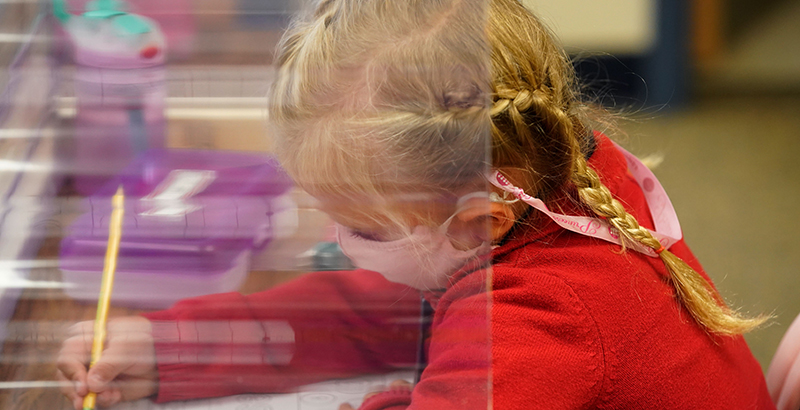To Close Pandemic Academic Gaps, Experts Point to a ‘Cascade’ of Skills Young Kids Will Need To Work On

Get stories like this delivered straight to your inbox. Sign up for The 74 Newsletter
At his Kumon Math and Reading Center Franchise in San Antonio, Sarit Kapur is used to working with kids who are at risk of falling behind.
Now, said the tutor, after the effects of the pandemic, not only is the risk a reality, but the gap is growing.
“A lot of kids who were on the borderline before all the virtual stuff, they have fallen behind,” said Kapur, who can see just how wide the gulf has become for students who have spent two years in pandemic schooling because he begins tutoring at whatever level a child has mastered, not the level their age and grade suggest.
The last time most second graders had the kind of instruction that lends itself to mastering reading skills, Kapur said, was the first half of kindergarten in 2019.
It’s no secret that early academics across the country took a hit during the pandemic: Closures, masks, and distance learning changed the way students learned to read, and it often wasn’t as good as what they had in person.
Now, experts say, for young students to fully recover will take more than picking up where they left off two years ago. They point to the social emotional and behavioral skills that cascade into reading, and warn against the temptation to rush things along.
Whether going back to fill in the gaps with a tutor like Kapur, or accelerating to keep kids on grade level, as most schools are doing, experts say kids will progress if the adults keep their social and emotional health and mind, and be patient.
In an ordinary year, young students would be honing their reading based on years of foundational literacy skills like listening, speaking, and following sentences along a page.
And it’s more than just functional reading skills: By first grade they would also be old hands at raising their hands, veterans of circle time, practiced in the rhythms of the classroom.
It’s training a lot of early elementary school kids have not had. In addition to the challenges of pandemic schooling for students who were enrolled in school, national data show more parents opted to keep their young children out of pre-K and kindergarten during the pandemic, which means more children than usual are encountering classroom learning for the first time this year.
Learning to read is more than letter and sound recognition, Kapur said. He has always worked with pre-K students on holding a pencil and focusing for longer than a couple of minutes at a time. These would usually be skills needed to be “kinder-ready” he said, but he’s seeing more kids at older ages needing help.
“There has definitely been an uptick, especially the kids who were not at school,” he said.
Studies confirm that uptick in kids behind grade-level in reading. The University of Virginia reported that the number of 1st graders failing to meet grade-level was up by 18 percentage points. A nationwide study showed losses in reading were concentrated predominantly in early grades, kindergarten through 2nd. These are usually critical years for literacy, as by 4th grade most students are expected to have learned to read, so they can start “reading to learn.”
For those young readers, especially pre-K and kindergarten, Kapur said, virtual learning couldn’t give them everything they needed. They needed to be in classrooms. But even that wouldn’t be the silver bullet many hoped.
Getting Back Into Classrooms Didn’t Solve Everything
Even as kids have gotten back into classrooms, something many predicted would help tremendously, teachers say the second year of the pandemic was still far from ideal. Intermittent closures or returns to virtual learning interrupted the school year, plus, it’s difficult to care about a sentence like “A rat has a hat,” when so many have been worried about the health of family members. It’s difficult to understand the difference between the “m” sound and the “n” sound when a teacher’s mouth is behind a mask.
Now that masks have begun coming off, and closures are fewer and further between, teachers are turning their attention to the cascade of skills students need to read fluently before 4th grade.
Clinicians say in children and adults, the pandemic had an effect on perseverance, attention, and other factors known in developmental science as “executive functions” that make learning possible. The solution, they say, is to prioritize what feel like “non-academic” skills right alongside reading and math.
“To get to the academics there’s more you need to know about your students,” said LaMonica Williams, director of early reading programs at Teaching Matters, a New York-based coaching and mentorship nonprofit for teachers in low-income schools.
It’s not as simple as just doing more flashcards or sending home more books. “A different level of engagement is required as we’re bringing students back,” Williams said. Teachers need to know what happened to students during the pandemic, and how they are feeling about being back in the classroom. What’s still worrying them? Where do they feel frustrated?
Less-Than-Ideal Environments
In California’s Palo Alto Unified School District, educators are seeing a familiar divide between children whose parents could afford private, in-person programs while schools were closed, and those who rely exclusively on public schools.
Disparities have always existed between the relatively small number of low income Black and Latino students in Palo Alto, and white and Asian students who historically saw better outcomes. That data prompted Palo Alto to develop the Every Student Reads Initiative before the pandemic.
Because the initiative was built with differentiation and acceleration in mind, Palo Alto administrators expect it to be relevant in addressing the gaps exacerbated by the pandemic, when research is showing the best practice will be keeping kids with their grade level peers and reinforcing missing skills at an accelerated rate, rather than putting kids in remedial classes.
More students might need the support, but the district plans to rally resources accordingly. For instance, summer programming—usually an enrichment program for low-income kids—offered direct reading instruction for any student behind their grade level in reading. The more time with teachers, the better, said Anne Brown, Palo Alto assistant superintendent of elementary education.
In a classroom, students have the predictability of schedules, rules, and rituals to help settle them into a learning-ready frame of mind. Time spent away has had a domino effect on other areas of learning.
Cascades
Teachers and parents can expect to see academics like reading develop hand in hand with social and emotional maturity, said Catherine Tamis-LeMonda, professor of applied psychology at New York University’s Steinhardt School of Culture, Education, and Human Development. “Any given skill is the outcome of many many things coming together.”
In Steinhardt’s Play and Language Lab, Tamis-LeMonda studies the phenomenon of “developmental cascades”—skills that spill over into each other in early childhood. For instance, children develop social and emotional skills while learning new words to express their feelings.
The pandemic affected many of these cascades as students were isolated and anxious, she explained, but there’s good news: Those skills might have fallen down like dominoes but they can develop concurrently as well.
“Practice…will make you a master at any given skill,” she said.
Sitting still is an area for gradual, age-appropriate, pandemic-adjusted development, just like reading, Tamis-LaMonda said, and she encourages parents who want to help, to build the skill like you would any other: patiently. For instance, if a kid doesn’t want to sit longer than five minutes to look at sight words, she recommends trying to build up to ten high-quality minutes instead of forcing a miserable hour.
Get stories like these delivered straight to your inbox. Sign up for The 74 Newsletter

;)
